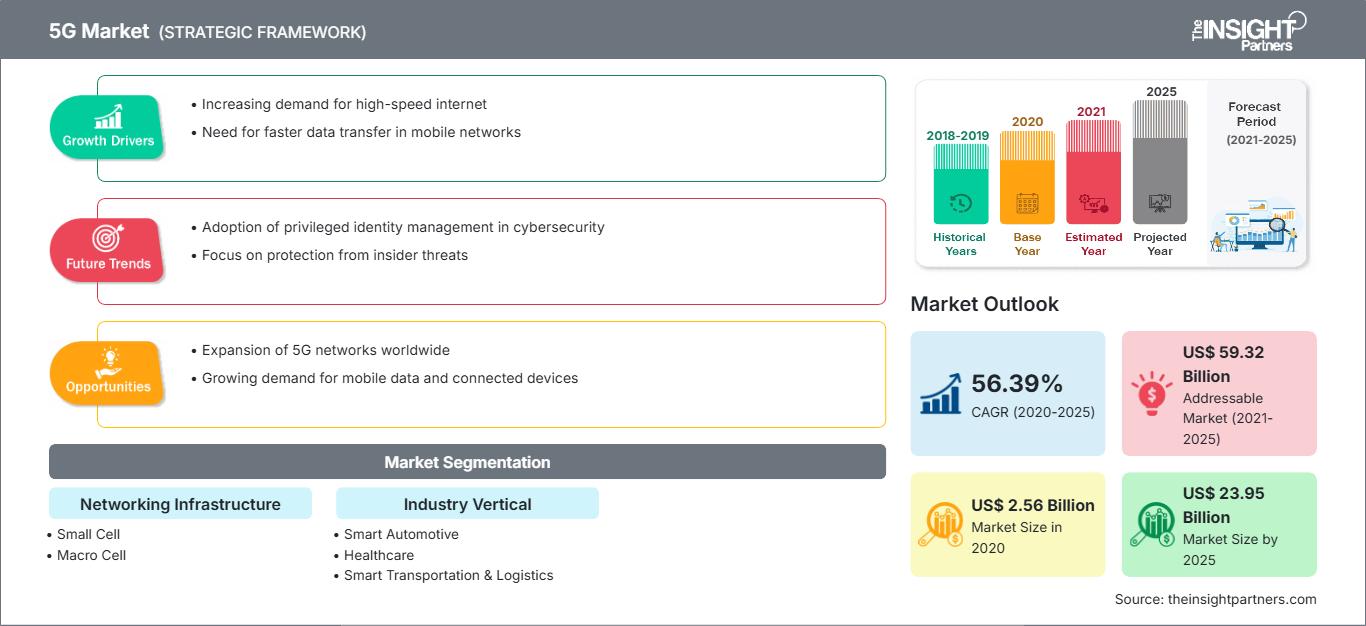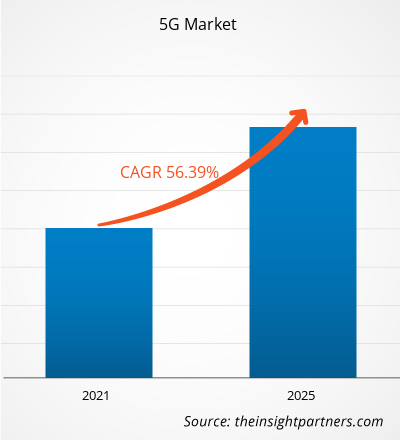Se espera que el mercado 5G crezca de US$ 2.560 millones en 2020 a US$ 23.950 millones en 2025 a una CAGR del 56,39% entre 2020 y 2025.CAGR of 56.39% between 2020 and 2025.
El 5G se emplea en tres tipos de servicios conectados: banda ancha móvil mejorada, comunicaciones de misión crítica y el enorme Internet de las Cosas (IoT). La compatibilidad con versiones posteriores es una característica de la tecnología 5G, lo que significa que puede utilizarse con una amplia gama de dispositivos, como smartphones, portátiles, sistemas de seguridad y más. También ofrece la flexibilidad para gestionar servicios futuros que requieran mayores velocidades de internet y una latencia ultrabaja. La tecnología móvil 5G puede dar paso a nuevas experiencias inmersivas, como la realidad virtual (RV) y la realidad aumentada (RA), con velocidades de datos más rápidas y consistentes, menor latencia y un menor coste por bit, además de mejorar los smartphones. Con redes ultrafiables, accesibles y de baja latencia, el 5G puede habilitar nuevos servicios que pueden transformar sectores, como el control remoto de infraestructuras clave, la automoción y las operaciones médicas. Además, se prevé una mayor demanda de velocidades de datos a medida que crece la demanda de edge computing y la cantidad de datos generados por los dispositivos IoT. Por lo tanto, la creciente penetración de la tecnología IoT contribuye al crecimiento del mercado 5G.
Se prevé un alto crecimiento del mercado global del 5G en el futuro próximo. Entre los principales factores que contribuyen a este crecimiento se encuentra la creciente necesidad de una infraestructura de red de comunicaciones energéticamente eficiente. Asimismo, se espera que la creciente demanda de integración de redes en los aspectos funcionales de la infraestructura para lograr una red eficiente impulse significativamente la industria del 5G. Según Qualcomm, el 5G se ha implementado en más de 60 países de todo el mundo y continúa creciendo. Según la compañía, la tasa de penetración y adopción del 5G es mucho mayor que la del 4G. El aumento de la concienciación sobre los beneficios del 5G está impulsando la adopción de esta tecnología, lo que, en última instancia, está impulsando el mercado del 5G. Asimismo, según Qualcomm, se espera una inversión global de 265 000 millones de dólares en la industria del 5G durante los próximos 15 años. Debido a la enorme inversión futura, se prevé un crecimiento prometedor del mercado.
Obtendrá personalización en cualquier informe, sin cargo, incluidas partes de este informe o análisis a nivel de país, paquete de datos de Excel, así como también grandes ofertas y descuentos para empresas emergentes y universidades.
Mercado 5G: Perspectivas estratégicas

-
Obtenga las principales tendencias clave del mercado de este informe.Esta muestra GRATUITA incluirá análisis de datos, desde tendencias del mercado hasta estimaciones y pronósticos.
Perspectivas del mercado 5G
Fomentar el apoyo y las inversiones gubernamentales en las economías en desarrollo de todo el mundo
Varios países en desarrollo económico están priorizando la mejora de su conectividad a internet. Debido a esto, las inversiones en tecnología 5G crecen continuamente, impulsando el mercado 5G en estos países. Por ejemplo, el gobierno de Arabia Saudita ha intensificado su enfoque en el desarrollo de la tecnología 5G para alcanzar el objetivo VISIÓN 2030 del país de convertirse en una economía líder. Empresas líderes de telecomunicaciones como Ooredoo (Catar) y Etisalat Group (EAU) están implementando diversas medidas para impulsar la tecnología 5G en sus respectivos países. Además, el gobierno mexicano trabaja en un proyecto llamado Red Compartida para mejorar la conexión en todo el país. El objetivo de este proyecto es desarrollar una red 5G en México utilizando tecnología LTE. Asimismo, países como Argentina, Chile y Colombia han tomado medidas para invertir en tecnología 5G mediante acuerdos con importantes empresas de telecomunicaciones como Nokia y Huawei Telecommunications. Por lo tanto, los factores mencionados han contribuido al crecimiento del mercado 5G. Además, India está a punto de desplegar su red 5G, según el gobierno indio. Esta tecnología se encuentra en su fase final de desarrollo y el gobierno espera una adopción masiva en los próximos cinco años. Esto impulsaría significativamente el mercado 5G en el país. China y Japón se encuentran entre los países clave en el mercado asiático del 5G, mientras que se espera que India se convierta en uno de los países más prometedores en este mercado.
Perspectivas del mercado basadas en sectores verticales de la industria
La automatización de edificios y hogares es el sector vertical líder del mercado. Según IDC, se espera que las inversiones en tecnología para ciudades inteligentes alcancen los 135 000 millones de dólares estadounidenses para 2021. Se prevé que las tecnologías 5G sirvan de base para las redes de celdas pequeñas que impulsarán la próxima generación de infraestructura inalámbrica en una ciudad inteligente, lo que representa una oportunidad rentable para el mercado de la tecnología 5G durante el período de pronóstico.
Perspectivas regionales del mercado 5G
Los analistas de The Insight Partners han explicado detalladamente las tendencias y los factores regionales que influyen en el mercado 5G durante el período de pronóstico. Esta sección también analiza los segmentos y la geografía del mercado 5G en Norteamérica, Europa, Asia Pacífico, Oriente Medio y África, y Sudamérica y Centroamérica.
Alcance del informe de mercado 5G
| Atributo del informe | Detalles |
|---|---|
| Tamaño del mercado en 2020 | 2.560 millones de dólares estadounidenses |
| Tamaño del mercado en 2025 | US$ 23.95 mil millones |
| CAGR global (2020-2025) | 56,39% |
| Datos históricos | 2018-2019 |
| Período de pronóstico | 2021-2025 |
| Segmentos cubiertos |
Por Infraestructura de Red
|
| Regiones y países cubiertos |
América del norte
|
| Líderes del mercado y perfiles de empresas clave |
|
Densidad de actores del mercado 5G: comprensión de su impacto en la dinámica empresarial
El mercado 5G está creciendo rápidamente, impulsado por la creciente demanda de los usuarios finales debido a factores como la evolución de las preferencias de los consumidores, los avances tecnológicos y una mayor conciencia de los beneficios del producto. A medida que aumenta la demanda, las empresas amplían su oferta, innovan para satisfacer las necesidades de los consumidores y aprovechan las tendencias emergentes, lo que impulsa aún más el crecimiento del mercado.

- Obtenga una descripción general de los principales actores clave del mercado 5G
Los actores del mercado 5G adoptan estrategias como fusiones, adquisiciones e iniciativas de mercado para mantener su posición en el mercado. A continuación, se enumeran algunos avances de los actores clave:
- En 2018, AT&T firmó un acuerdo con Crown Castle International Corp. para ampliar y simplificar su contrato de arrendamiento continuo de infraestructura de red inalámbrica. Las operaciones y la gestión de este arrendamiento se modernizaron para mejorar la flexibilidad y la eficiencia mediante la implementación de nuevas tecnologías y el aumento de la capacidad de la red.
- En 2018, Cisco anunció su colaboración con Saudi Telecom Company (STC) para el desarrollo de sistemas y redes de comunicaciones 5G en Arabia Saudita. En virtud de este acuerdo, Cisco transformará el desarrollo de las perspectivas comerciales de las redes móviles 5G.
- Análisis histórico (2 años), año base, pronóstico (7 años) con CAGR
- Análisis PEST y FODA
- Tamaño del mercado, valor/volumen: global, regional y nacional
- Industria y panorama competitivo
- Conjunto de datos de Excel
Informes recientes
Informes relacionados
Testimonios
Razón para comprar
- Toma de decisiones informada
- Comprensión de la dinámica del mercado
- Análisis competitivo
- Información sobre clientes
- Pronósticos del mercado
- Mitigación de riesgos
- Planificación estratégica
- Justificación de la inversión
- Identificación de mercados emergentes
- Mejora de las estrategias de marketing
- Impulso de la eficiencia operativa
- Alineación con las tendencias regulatorias






















 Obtenga una muestra gratuita para - Mercado 5G
Obtenga una muestra gratuita para - Mercado 5G